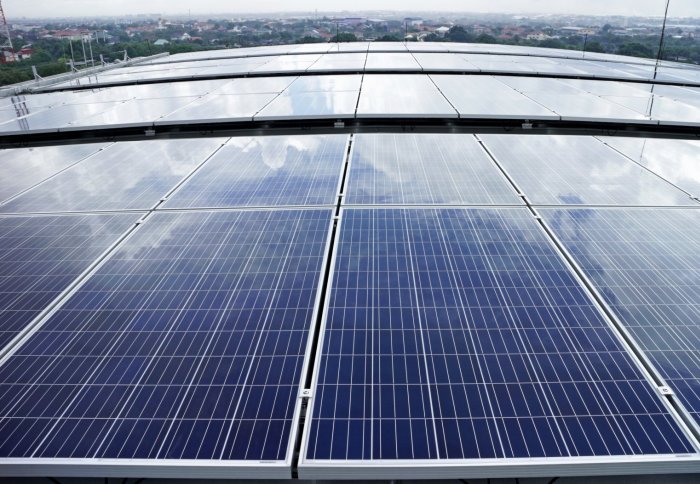Alternative solar cells ramp up efficiency and stability

Imperial researchers are designing cheaper and more flexible solar energy materials, set to rival traditional rigid silicon panels.
Solar cells are formed of light-absorbing materials that convert sunlight into electricity. The panels we are used to seeing covering fields or roofs of houses are made primarily from silicon.
However, silicon panels are energy-intensive to produce, heavy and inflexible. Research groups around the world are working on alternatives based on flexible ‘organic’ materials – plastics – that can be printed from inks. This research could lead to transparent solar modules in windows, as well as large scale electricity-generators or even integration into clothing.
Organic solar materials offer a lot of promise, but there are still challenges to overcome before they can compete with silicon panels. For example, solar cells made from organic ‘perovskite’ materials have poor stability – the cells often break down in sunlight in a matter of hours – and include toxic elements like lead.
PhD student Andrew Wadsworth, from the Department of Chemistry at Imperial, is part of a team developing organic solar cells. Hayley Dunning talked to him about how they are tackling the obstacles and improving device performance.
What type of solar cells do you research, and what are some of the challenges?
Our group looks at cells based on semiconducting polymers, often working with a material called poly(3-hexylthiophene) (P3HT). This is one of the few semiconducting polymers that can be produced on a large scale and is much more stable in comparison to many of the high-performance polymers that have been reported.
However, until recently, P3HT-based solar cells have only been able to deliver a modest performance in comparison to many other polymer solar cells, not to mention perovskite and silicon cells. It is also worth noting that polymer solar cells often suffer from poor stability, though not to the same extent as many perovskites.
How have you been improving P3HT cells?
Organic solar cells typically consist of a blend of two materials – the first generates electrons in response to sunlight (the electron donor), and the second takes these electrons away to create electrical charges and thus energy (the electron acceptor). In the past couple of years we have improved on this concept, designing electron acceptors that can also absorb light (at different wavelengths to the electron donor) and generate electrons. This increases the overall power conversion efficiency of the solar cell - the percent of the solar energy that can be converted into electricity.
We recently invented a system that is more efficient and more stable than any P3HT-based system reported to date. Whereas most cells contain only one electron donor and one electron acceptor, we devised a system in which one electron donor and two different electron acceptors are used. This is known as a ternary solar cell. The addition of the second electron acceptor was shown to improve the efficiency, operational stability and storage lifetime.
How do their efficiencies compare to silicon solar cells?
The best silicon devices currently offer efficiencies of over 25 percent with respectable lifetimes. Perovskites can get close to these efficiencies, but their stability and environmental issues prevent them from being a viable alternative.
Our new P3HT ternary cells can achieve efficiencies of around eight per cent. Despite lower efficiencies than silicon cells, the energy payback of our ternary solar cell is better – less energy needs to be invested into the manufacturing process, and therefore the output energy of the ternary solar cell can exceed its lifetime input energy at least as quickly as silicon cells.
What challenges remain?
Whilst we have made great progress in improving the stability of P3HT-based organic solar cells in our ternary system, we still haven’t fully reached the performance limits and are working hard to investigate this further. We would also like to improve the efficiencies that our ternary cells can achieve, without sacrificing the stability, making them even more commercially viable.
-
‘Reducing the efficiency-stability-cost gap of organic photovoltaics with highly efficient and stable small molecule acceptor ternary solar cells’ by D Baran et al is published in Nature Materials.
Article text (excluding photos or graphics) © Imperial College London.
Photos and graphics subject to third party copyright used with permission or © Imperial College London.
Reporter
Hayley Dunning
Communications Division